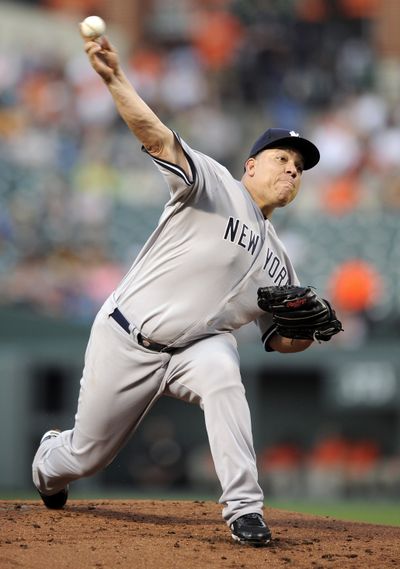Colon’s recovery after stem-cell surgery a sign the future of sports medicine has arrived

PHILADELPHIA – Bartolo Colon is 38. He is not the best-conditioned pitcher on the planet. Bart’s playing field should be a lily pad. He should be zapping flies, not breaking bats.
By 2009, the right arm that won the American League Cy Young Award in 2005 hung limp as a soup-kitchen dishrag. His elbow was shot. His rotator cuff was torn. The labrum had seen better days. The guy’s MRI showed so many loose bodies, it looked like a 1950 TV test pattern.
It hurt like hell when he tried to throw. The rest of the time it was just a dull ache. When he threw a bullpen session, kids would yell, “Hey, Bartolo, if it hurts don’t throw it.” That disaster of an arm led to elbow surgery and kept him out of baseball last season.
Clearly, it was the end of the line. Not to mention, he was almost grotesquely out of shape, not that he wore a Body by Pujols in his best days.
Colon was Joe Blanton XXL with better mechanics and a wicked fastball. But all that weight, all that effort it took him to throw in the mid-90s had worn him down.
In other words, he was exactly the kind of train wreck a Boca Raton, Fla., orthopedic surgeon named Dr. Joseph R. Purita looks for. A perfect candidate for stem-cell surgery that would do for fat and bone-marrow cells what Dr. Robert Jobe did for the ulnar-ligament transplant that was named for the guinea pig, Dodgers left-hander Tommy John.
Purita had done successful stem-cell surgery before, but he had included injections of human growth hormone, which is banned by Major League Baseball. The idea of the HGH was not to turn the patient into Barry Bonds – indeed, Purita claims he has never used HGH on a baseball or football player – it was to hasten the healing process.
He knew that once Colon asked one of his Dominican Republic associates if he could try the procedure as a career last resort, it would have to be done without HGH. MLB’s knee-jerk reaction to the new procedure would be extreme enough without having to ask the PED cops for an exemption.
A team of stem-cell docs headed by Purita performed the surgery on Colon in the Dominican Republic last summer. They harvested fat – no problem there – and healthy cells from the pitcher’s bone marrow and infused it into his bum elbow and ravaged shoulder. Purita worked pro bono.
The rest is exciting history. The Yankees sent a delegation to the DR last winter and they were amazed that Colon, hardly in pitching shape, was throwing fastballs in the low 90s.
Amid a lot of what- the-hell-can-they-be- thinking reaction, the Yankees signed Colon. Yankees general manager Brian Cashman said that when they signed Colon, they had no knowledge he had undergone the stem-cell procedure and didn’t learn about it until recently. I guess when Colon started hitting 95 mph on a regular basis, Cashman figured he better alert MLB.
The stem-cell infusion went from minor miracle to Lourdes level Monday when Colon shut out the Oakland A’s with a complete-game four-hitter. No walks, six strikeouts, 103 pitches. His fastball hit 97 mph, right up with where he was in 2005 when he won 21 games.
If you’ve plugged into the implications of all this, then you should be giddy with hope and surmise.
Weird Science has just taken an order for a completely healthy Chase Utley on a silver home plate. There he is in 2012 with a right patella tendon that has been regenerated to 100 percent by stem-cell infusion.
And no more barely tickling 90 for Brad Lidge. If a 38-year-old whale like Colon can get back his 97 mph mojo, why can’t Charlie Manuel’s former closer get back the fastball-fire and slider-brimstone he had when he was unhittable in Houston?
Here’s Blanton showing up for spring training 2012 with a healthy arm, the elbow injuries healed, his soupbone as strong as when he was just a big old farm boy fogging the ball from that pitching version of the missionary position – straight up and down.
Who else?
Chipper Jones is battling the right-knee miseries again. He had a cortisone shot two weeks ago, but can’t have another one for months. Could stem cell be his fountain of youth? A once-and-for-all solution for the chronic arm problems of brilliant young Miami ace Josh Johnson? A procedure that will make the more invasive Tommy John and its year-plus rehab time obsolete?
On the first day of Phillies minor spring training nearly three months ago, Tyson Gillies, the young center fielder acquired in the Cliff Lee trade with Seattle, blew out his hamstring again running a post-scrimmage wind sprint. Tuesday afternoon, the legally deaf Canadian finally began a rehab assignment in an extended spring training game. Could stem-cell regeneration restore Gillies’ race-horse legs to their factory settings?
Ah, but best to curb our enthusiasm while MLB’s medical big brains ascertain if this is on the up-and-up. The same group of surgeons doing the stem-cell stuff is also doing platelet-enrichment therapy that may or may not include the use of HGH.
If the procedure Purita and his Dominican team performed was as described – taking fat and healthy bone-marrow cells and injecting them into a damaged shoulder and elbow – how different is that physically and ethically from Tommy John?
It sounds to me like the future of sports medicine just became the now. And welcome to it.